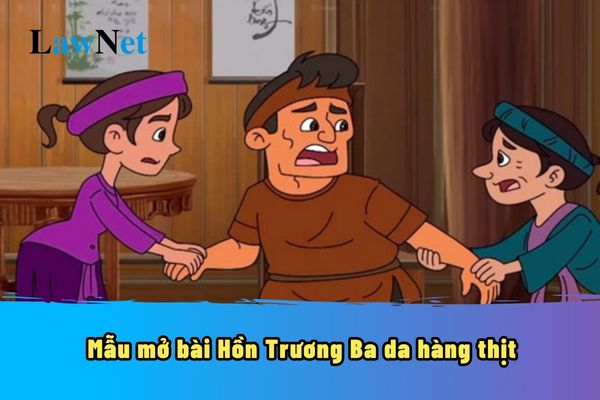Vietnam: What are the sample introductions for essays on the work "Hồn Trương Ba Da Hàng Thịt"? What genre does the work "Hồn Trương Ba Da Hàng Thịt" belong to?
What are the sample introductions for essays on the work "Hồn Trương Ba Da Hàng Thịt"?
Students can refer to the following sample introductions for essays on the work "Hồn Trương Ba Da Hàng Thịt":
|
Sample introductions for essays on the work "Hồn Trương Ba Da Hàng Thịt" Sample 1: Emphasize the Conflict |
*Note: The information is for reference only./.

What are the sample introductions for essays on the work "Hồn Trương Ba Da Hàng Thịt"? What genre does the work "Hồn Trương Ba Da Hàng Thịt" belong to? (Image from the Internet)
What genre does the work "Hồn Trương Ba Da Hàng Thịt" belong to?
Under Section 9 Appendix of the General Education Program for Literature issued with Circular 32/2018/TT-BGDDT:
IX. SUGGESTED LIST OF TEXTS (TEXT CORPUS) FOR SELECTION IN GRADES
...
GRADE 10, GRADE 11, AND GRADE 12
- ...
Plays, aulacese opera
- Plot and Love (F. Sile)
- A Midsummer Night’s Dream (W. Shakespeare)
- Hồn Trương Ba, Da Hàng Thịt (Luu Quang Vu)
- Kim Nham (Folk cheo)
- Mùa hè ở biển (Xuan Trinh)
- Nghêu, Sò, Ốc, Hến (Vietnamese Folk Tuong)
- Rừng trúc (Nguyen Dinh Thi)
- Vũ Như Tô (Nguyen Huy Tuong)
- ...
Therefore, according to the above regulations, "Hồn Trương Ba Da Hàng Thịt" is a work belonging to the play genre.
What are the requirements for selecting the text corpus used in the Literature curricula in Vietnam?
Under Section 8 Appendix of the General Education Program for Literature issued with Circular 32/2018/TT-BGDDT, the requirements for selecting the text corpus used in the Literature curricula in Vietnam are as follows:
- Besides ensuring the criteria stated in section V, text corpus used in the Literature curricula must meet the following requirements:
+ Ensure a reasonable ratio between literary texts, argumentative texts, and informational texts. In literary texts, ensure a relative balance between the basic genres (story, poetry, prose, play), between medieval and modern literature, between folk and written literature, between Kinh and minority literature, between Vietnamese and foreign literature, and between East and West.
“Balance” is understood as an appropriate ratio, not an equal proportion. Materials for all grades must include narrative and poetry texts. Besides narrative and poetry, each educational level must include prose or play.
Grades at the primary and early lower secondary levels prioritize modern and contemporary Vietnamese literature. Limit the repetition of texts across different grades and educational levels.
+ Ensure the suitability of the text with the development requirements and learning time of the curriculum. The difficulty of the reading materials increases gradually each academic year.
The teaching time for a text must correspond to its length and complexity to ensure that teachers can help students fully and deeply access the text, allowing students to have the opportunity to directly and completely read the selected works.
Limit the teaching of excerpts, except in the case of literary works with a large volume such as novels, autobiographies, and epics, for example: "Truyện Kiều" by Nguyen Du.
+ Ensure the inheritance and development of existing Literature subject programs. The curriculum is based on 9 authors and literary works taught in the current program and textbooks, choosing and adding some authors, and works with important positions, representing the outcomes of national literature through periods to be taught in schools with three levels: compulsory works (which textbook authors and teachers must implement according to program regulations); compulsory selection works (textbook authors must select works by authors named in the curriculum's prescribed list); suggested selection works (textbook authors can choose works according to the curriculum's suggested list).
Specifically, for 3 authors: Nguyen Trai, Nguyen Du, and Ho Chi Minh at the upper secondary level, there are additional overview introductions of the literary authors.
Based on the required outcomes for each grade and the list of compulsory works, compulsory selection works are regulated, and textbook authors select additional suitable texts recommended inside or outside the suggested list at the end of the curriculum.
Teachers and students are allowed to select many expanded texts suitable to the curriculum and age requirements for discussion in groups, in the class.

